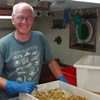General Description
Eye with subglobular cornea. Rostral plate broadly quadrate with apical spine. Antennal protopod with 2 mesial and 1 ventral papilla. Last segment (dactylus) of raptorial claw with 8-11 teeth. Pereopods 1-2 basal segment with inner and outer spine; pereopod 3 with outer spine only. Abdominal somite 6 with 2 ventrolateral spines anterior to uropod articulation. Tailfan (telson) with low median prominence terminating in acute spine; lateral proximal margin without distinct semicircular lobe; intermediate denticles elongate, triangular. Up to 4.5 cm.
Biology
Slender Mantis Shrimps seldom leave their burrows and are ambush predators that feed on passing soft bodied prey such as small fish, cephalopods and shrimps. Consequently they are less frequently encountered than other species which actively forage. The common name stomatopod is sometimes used, after the Order Stomatopoda to which they belong.
Habitat
Shallow, soft substrates, to 110 m depth.
Soft substrates
Distribution guide
Southern temperate oceans, including southern Australia.
Species Group
Prawns, shrimps, lobsters › Mantis shrimps
Depth
Shallow (1-30 m)
Deep ( > 30 m)
Water Column
Max Size
4.5 cm
Diet
Carnivore
Commercial Species
No
Global Dispersal
Native to Australia
Species Code
MoV 1619
Conservation Status
- DSE Advisory List : Not listed
- EPBC Act 1999 : Not listed
- IUCN Red List : Not listed







